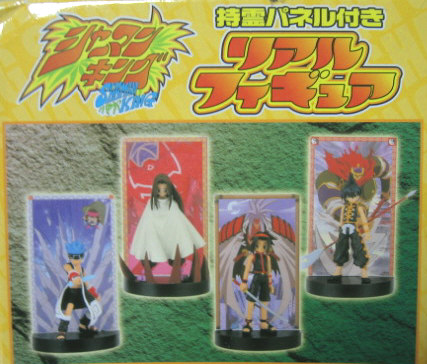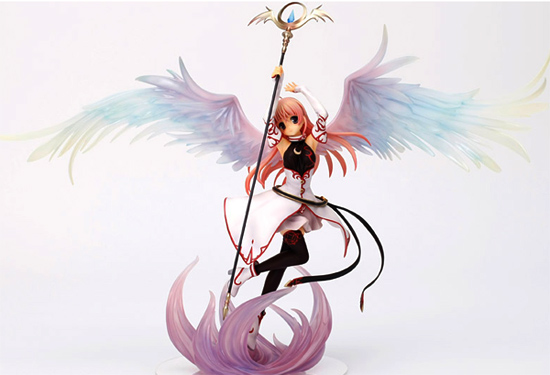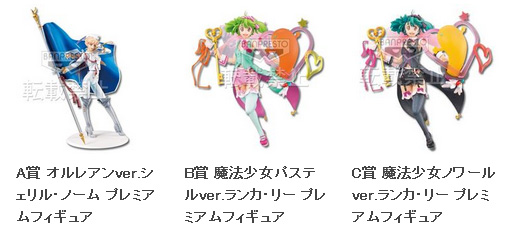Here’s the first part of the guide that I promised! This covers the basics of anime figure collecting, such as what they are, how they’re made, and the different types. I’m mostly done with the next part which I know is what everyone actually wants – HOW TO SPEND YOUR MONIES ON EXPENSIVE PIECES OF PLASTIC! HURRAH!
But for now, let’s preface with the basics…after the jump.


Figure Collecting Part 1: The Basics
What are figures? Why do they exist?
Figures, anime ones in this case, are sculpted statuettes of characters from various series, video games, manga, and well-known illustrations. They are usually scaled, meaning that it is only a fraction of the actual perceived height of the character. Figures are most often ⅛, 1/7 and ⅙ scale, meaning that if you stacked 8, 7, or 6 figures on top of each other respectively, they would be the actual size of the character. That said, most figures are only about 7-9in (18-23cm) tall.
As for why they exist…well, some just like having their favorite characters on display, or they just find the figure itself beautiful or handsome and want it for themselves. Some keep the figure in its box while displaying it, which, depending on the box, can make it hard to see, and some take the figure out and let it sit or put it behind glass. Either way, opening the figure makes it slightly less valuable if you try to resell it. The other reason they exist? PEOPLE BUY THEM! Companies don’t really make squat by simply airing anime on TV; figures are one of the fastest and most reliable ways for a company to make money off of a license. The thing is, not only one figure of a character is usually made – over 240 figures of Ayanami Rei from Neon Genesis Evangelion have been made since the series was created, an average of 15 each year. With dozens of companies, there is an immense potential for profit.
What are figures usually made out of?
Polyvinyl chloride, commonly known as PVC, is usually the go-to material for figures. It’s cheap, durable, and easy to build with. You can make anything from clothes to hoses to roofing to flooring to waterbeds.
Wait…isn’t PVC toxic?! Why are you telling us to buy something that could kill us?!
Darn, you discovered my diabolical plan to kill off people who bug us about updates!
No, seriously though, while it’s true that PVC can be toxic, as long as all your furniture, walls, and carpeting aren’t made out of 100% PVC, and you’re not sniffling, licking, or making out with your figures everyday, you’ll be fine. There’s a gentleman on a website who has thousands, and he’s still alive and kicking!

What about other materials?
Some other materials include resin and polystone. Every now and then you’ll have a company who’s being all fancy and making a figure out of gold or diamonds, but those cover the most common types of materials. Having a figure made of resin or polystone usually make them much more expensive, and have a higher chance of being broken. If a method called “cold cast” is used (wherein the material does not use heat in order to make the figure, and an accelerator is usually added to the liquid plastic in order to hasten the process), the figure will be EXTREMELY brittle and much more likely to break. I stress that you should use caution when deciding to buy a cold cast figure. They’re super expensive, and they may not even arrive in one piece!
How is figure formed?
Here’s a site that can explain it in brief and also offers a series of videos about how anime figures are made. Yes, they’re all in Japanese with no subtitles, but you can get the basic idea if you’re actually curious. It’s pretty interesting.
What’s a garage kit?
Garage kits are basically the doujinshi of the figure world. Small, unofficial groups sculpt their own figures, which they then usually sell at conventions like Wonder Festival. They are almost always sold unpainted and unassembled, so you need to either do it yourself or commission someone else to do it for you.
These can be an awesome way for more under appreciated anime series to be recognized, but the downside if that because it’s made by an indie group, very few are made. On average, only 20 kits are made, if even that. If the group is lucky and the sculpt is really good, a major figure company may pick it up and release a prepainted PVC version.
Even major companies sometimes do garage kits. In fact, Volks, who made this Shaman King figure that is both Andy’s and my holy grail, produced this as a garage kit. That’s right, after paying $400 for this, you have to paint it yourself! Yay! Not to mention that even those are sold in limited quantities. Only 100 of those figures exist!
What does it mean when a figure is limited? Exclusive? Made-to-order? Prize?
Each of these classifications is considered a “run”. Most figures have a “standard run,” that is, they are sold in most stores that would sell anime figures, and you shouldn’t have too much trouble getting it via preorder or buying it if there are any leftovers. More often than not, a standard run is only produced once. When the figure sells out, that’s it – good luck with the second hand market. Occasionally figures are re-released, but I’ve noticed that only bigger companies such as Alter and Kotobukiya reprint figures. In the case of the RIO:bones, we don’t know much about Sentinel, the company that produces them, so we can’t say if they will be a company that does re-releases. Better to be safe than sorry, and preorder when you can.
 A “limited” figure only has a certain number that are made. The Yoh figure mentioned above was only limited to 100 pieces as I said. These figures are almost never re-released (I say “almost” because knowing the crazy world of figures, it’s probably happened at some point), so expect the price to skyrocket if you’re not lucky enough to initially buy it. These figures may or may not be sold in regular stores.
A “limited” figure only has a certain number that are made. The Yoh figure mentioned above was only limited to 100 pieces as I said. These figures are almost never re-released (I say “almost” because knowing the crazy world of figures, it’s probably happened at some point), so expect the price to skyrocket if you’re not lucky enough to initially buy it. These figures may or may not be sold in regular stores.

An “exclusive” figure can only be obtained from a certain source. Many times, figure shops will offer a figure that was made only for them to sell. For instance, AmiAmi sometimes sells figures that no other figure stores have. They are special figures that the company made for only AmiAmi to sell. The only way you can get one of these figures otherwise is through a proxy service, a figure shop that sells figures from all different runs, or second hand. These figures are not necessarily limited, but limited and exclusive often do go hand-in-hand. Another way to get an exclusive figure is through a mail order from a magazine. The magazine Hobby Japan often partners with top-tier figure companies to offer exclusive figures. There is usually a coupon that comes in the magazine, and you send it in to reserve your figure. Whether or not you pay at the time of order or when it is in stock is different based on who you’re ordering from. I personally find that these figures are of wonderful quality, and have a couple of regrets over not getting some. Another way to get smaller figures with magazines is to simply have them come with wrapped with the magazine itself. Manga and guidebooks also couple figures in special cases.
Made-to-order means just what it sounds like: you order a figure, and the number of figures that are ordered are made, no more (and hopefully no less). These usually come directly from the company themselves. A recent example is the Snow Miku nendoroid due out in June. The preorder was only open for 10 days, then closed. Nothing was sold out, it’s just that no more orders would be taken. There will be no extra stock because only the number of figures that have been ordered will be made. Chances of this being re-released are slim to none.
A “prize” figure is obtained by playing a lottery game in Japan, either that, or it is a prize in a crane game. These cannot usually be found in stores, only stores such as Hobby Link Japan and Big In Japan who cover multiple runs of figures.

Well, I think that’s it for this first part! Next up is the part I know people are really more interested in: BUYING!
See you then!
Figures featured in this post:
1. Shaman King Diorama figures: Ren | Yoh | Hao| HoroHoro
3. Touhou Project Hakurei Reimu figure: GK | PVC
5. Guilty Gear XX Λ Core Dizzy by Alter
6. Aiyoku no Eustia Eustia Astraea by Kotobukiya
7. Macross Frontier Ichiban Kuji figures: Sheryl | Ranka pastel | Ranka noir





